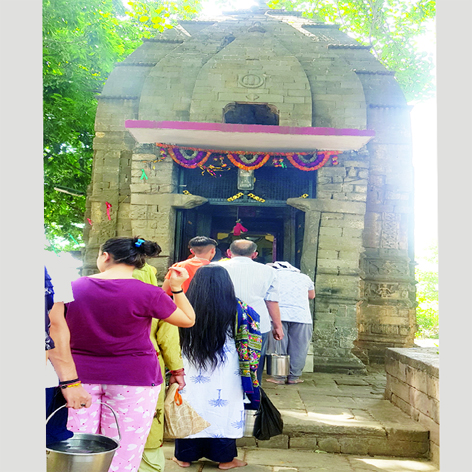Shiv Kumar Padha
Coming down the slopes of Himalayas, there is a town of rising temples Vishwasthali now named as Basohli, where, the ruins of a magnificent Palace dominate the whole landscape, where the mornings and evenings of the town resonate with the sounds of the temple bells and high notes of conch` shells emanating from the temples spread throughout the length and breadth of the town and where every local and social function starts and culminates with havan, yagyas and recitations of hymns . Vishwasthali has been the Kingdom of Raja Bhoopat Pal and Kirpal Pal, devotees of Vaishavnism, scholars of Sanskrit, who patronized the art of painting. During Raja Kirpal Pal regime two volumes on Ayurveda were published namely Charka: Ayurveda medicines and Sushrata: The Science of Surgery in Ayurveda written by Shri Kanth and Pt. Shiv Parsad in 1688. In the same period, BhanuDutt prepared a serial on Ras Majari, based upon the theme of love and romance, with a Sanskrit text given by Pt. Devi Dass of Nurpur in 16th century. Present, primeval town Vishawsthali of the Jammu region, was founded by Chandervanshi Raja Bhoopat Pal in 1635. Despite being a small town, Basohli has brought recognition to the mountainous state of Jammu and Kashmir not only at the National but also at the International level for its natural beauty and its miniature paintings, as a hub of sanatan, sanskriti and sanskars.
The princely state of Basohli was founded and ruled by the Pal Dynasty from 750 AD till the last Pal king Raja Kalyan Pal 1836 AD. If we go through the pages of ancient history of Basohli, which is hardly available, we find how great Vishavsthali had been in power, knowledge and spirituality during the times of Pal dynasty rulers of Basohli
The present town of Basohli (Latitude: 32.5038° N& Longitude: 75.8108° E) situated on the right bank of river Ravi is a panoramic valley with a mean elevation of 2170 feet. Basohli has an average literacy rate of 77% higher than the National average rate of 59.5%.
Town of pundits and astrologers.
It will not be an exaggeration, if I call Basohli as the land of renowned Pandits, dharma shastries, Poojaris and Astrologers whom Basohli Rajas had been inviting from time to time from Kashi, Ayodhya, Bengal and from other places of India. Basohli pandits had been known for their knowledge and mastery in astrology, horoscopy, predictions and for miraculous expertise They exercised control over aerial spirits and could treat many ailments by chanting hymns. Apart from the knowledge of their profession, all of them had been Sanskrit scholars. It is learnt that Pt. Balbhader Purohit of Basohli and his disciples took part in the coronation ceremonies of many Dogra Rajas of Jammu
Town of Temples
Due to the large number of temples all along the banks of the holy river Iravati, there were a number of temples in the beginning, middle and at the end of each street and bazaar. According to one estimate there had been more than 300 temples in and around the town Basohli before ponding of RSD with the reason Basohli was known as Lagu Kashi where the natives and the the people from the villages in its proximity used to immerse the mortal remains of their departed kins in it.. The banks of river Iravati used to echo with the rhythmical recitation of the Ved Mantras from the upnishadas. The Rajas, rich persons from the town used to give cows, coins and cash in donation to the Brahmins and the poor. The temples of Mata Chanclo Devi, Mata Sheetla, Mata Mahakali, Mahadera and Madir Neel Kanth are situated in and around the four corners of the town are believed, to have been guarding and protecting the natives from the natural disasters like, flood, earth quake, landslides, drought, famine, epidemic and lightening. The temples present in the town are in good condition as regards their decoration and maintenance. The natives do not believe in un touchability and are secular to the back bone. There is hardly any example of a town, except that of Basohli in the UT where the natives, without any Sikh family living there, have constructed a Gurudwara, maintaining it and have been observing all Sikh rituals with fervour and gaiety.
In the present time, it looks strange to imagine about a town like Basohli, where the natives especially the youth live in peace and restrain themselves from indulging in any sort of quarrel. The natives are god fearing, peace loving, hospitable, charitable, performers of religious ceremonies with the result not even a single case of theft, loot, murder, and stabbing or crime against women is ever reported in the police.
It is acknowledged that youth of Basohli is known for the moral and ethical values, are capable and intelligent and not second to anyone in the UT. It is the Basohli tehsil/town which has given top brass to police, Indian army, judiciary, young scientists, educationists, Excise and Taxation collectors, and women commercial pilot to the state. The living standard of the natives is very high and not inferior to anybody in the state.
The natives of Basohli are friendly, honest hospitable and god fearing. Economically they neither fall under the category of land lords, industrialists nor they are millionaires, their means of earning livelihood depends upon the crop produced in their farms, shop-keeping and Govt. jobs. Though the economy of the town is not that high as compared to their counterparts in other parts of the state but people are satisfied with what they earn and afford.
All these factors endorse the impact of Sanatana, Sanskar and Sanskriti on the lives of the natives which is clearly reflected in their style of living and their faith in the values of sanatana being perpetuated from generations.
Trending Now
E-Paper


